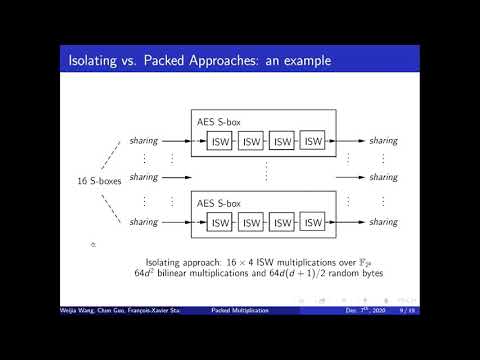Welcome to the resource topic for 2020/1103
Title:
Packed Multiplication: How to Amortize the Cost of Side-channel Masking ?
Authors: Weijia Wang, Chun Guo, François-Xavier Standaert, Yu Yu, Gaëtan Cassiers
Abstract:Higher-order masking countermeasures provide strong provable security against side-channel attacks at the cost of incurring significant overheads, which largely hinders its applicability. Previous works towards remedying cost mostly concentrated on local'' calculations, i.e., optimizing the cost of computation units such as a single AND gate or a field multiplication. This paper explores a complementary global’’ approach, i.e., considering multiple operations in the masked domain as a batch and reducing randomness and computational cost via amortization. In particular, we focus on the amortization of \ell parallel field multiplications for appropriate integer \ell > 1, and design a kit named {\it packed multiplication} for implementing such a batch. For \ell+d\leq2^m, when \ell parallel multiplications over \mathbb{F}_{2^{m}} with d-th order probing security are implemented, packed multiplication consumes d^2+2\ell d + \ell bilinear multiplications and 2d^2 + d(d+1)/2 random field variables, outperforming the state-of-the-art results with O(\ell d^2) multiplications and \ell \left \lfloor d^2/4\right \rfloor + \ell d randomness. To prove d-probing security for packed multiplications, we introduce some weaker security notions for multiple-inputs-multiple-outputs gadgets and use them as intermediate steps, which may be of independent interest. As parallel field multiplications exist almost everywhere in symmetric cryptography, lifting optimizations from local'' to global’’ substantially enlarges the space of improvements. To demonstrate, we showcase the method on the AES Subbytes step, GCM and TET (a popular disk encryption). Notably, when d=8, our implementation of AES Subbytes in ARM Cortex M architecture achieves a gain of up to 33\% in total speeds and saves up to 68\% random bits than the state-of-the-art bitsliced implementation reported at ASIACRYPT~2018.
ePrint: https://eprint.iacr.org/2020/1103
Talk: https://www.youtube.com/watch?v=yC3E6EJ4umc
Slides: https://iacr.org/submit/files/slides/2020/asiacrypt/ac2020/339/slides.pdf
See all topics related to this paper.
Feel free to post resources that are related to this paper below.
Example resources include: implementations, explanation materials, talks, slides, links to previous discussions on other websites.
For more information, see the rules for Resource Topics .
